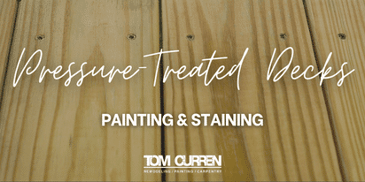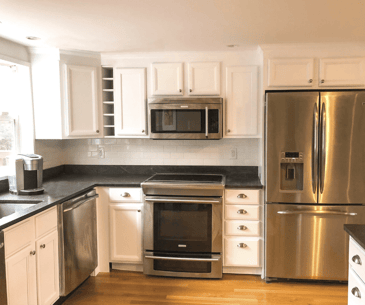
Blog
Your Home-Building Resource


Bathroom Remodeling – How Much Will It Cost? [Greater Boston Area 2023]
Remodeling your bathroom has many benefits – usually leaving your space more beautiful while updating its functionality to better serve your needs. Whether you want to do a full-gut remodel, or you just want to change out some fixtures and...

Painting or Staining a Pressure-Treated Deck
Do you know what pressure-treated wood is? You might be able to guess based on the name… Pressure-treated wood is a type of wood that has been specially treated to withstand environmental conditions and resist decay and insect damage. The...

How Much Does It Cost To Paint Kitchen Cabinets?
When a homeowner is thinking about cabinet refinishing, one of the first things they want to know is “how much will it cost to paint my cabinets, Tom?”
Well, of course, as with any home improvement project – that depends.

Bathroom Remodeling – How Long Does It Take? [Greater Boston Area 2023]
Are you happy with your bathroom– or do you have to ignore the outdated tile, small vanity, and other inconveniences that have kept you from loving your bathroom? Over the years, bathroom technology has advanced to provide you with any...

Pollinator-Friendly Gardening Tips For Homeowners in Greater Boston
Spring is the best time to awaken your dormant yard and embrace the season of resurgence. There are many ways to get your yard ready for Spring while keeping the pollinators top-of-mind.
Prepare to welcome buzzing bees, vibrant butterflies, and...

Cedar Shingles vs. Shakes vs. Clapboards – What’s The Difference?
When it comes to siding materials, cedar siding has always been a staple for homes in New England due to its durability, natural beauty, and resistance to pests and decay. It’s often used on traditional New England-style homes, as it...

Best Small Kitchen Paint Colors in 2023
Choosing paint colors for your small kitchen can be one of the hardest decisions you have to make while renovating. In recent years, all-white kitchens emerged as a major kitchen trend that many homeowners were choosing during remodeling and...

Can You Paint a House in the Winter in Massachusetts?
With summer lasting only a few short months, it can seem impossible to squeeze in everything you want to get done around your home. Not to mention, following a busy summer, your project might be waiting at the back of a long queue. Although...

The Best Siding Materials in New England
New England weather is known for being fairly unpredictable; so in a climate where your home will have to suffer through blizzards, hurricanes, and intense heat– your siding material matters. You need a siding material that can protect your...